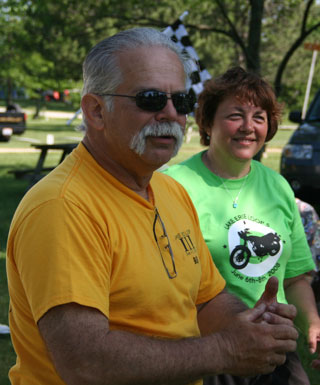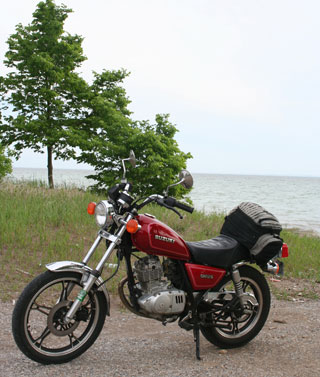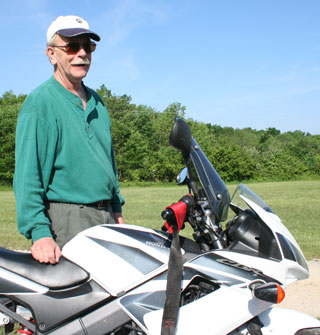This article was originally published in the September, 2008 issue of Backroads magazine.
The throttle has been jammed to the stop for several minutes, the engine is screaming above 9,000 rpm and I’m tucked in tightly, desperately seeking every last mph of top speed as I flee Detroit on I-75 south.
That’s when the SUV in the left lane sedately passes me at about 75 mph. The kids in the back seat turn to stare at me, then point and laugh.

Bill and Joyce Murar run the Lake Erie Loop charity fundraising ride.
Glancing at the gauges, I see the tach needle on the 1996 Suzuki GN125 start its slow descent once again and I nervously check the mirrors for inattentive drivers coming up fast behind me. Dammit! The bike just won’t stay above 60 mph in fifth gear on even the slightest uphill grade.
At this point, you may reasonably ask: What am I doing on I-75 in Detroit, a city where everyone drives big cars at 80 mph, on a bike once described by Iron Butt Rally commentator Bob Higdon as a “hairdryer on wheels”? You could blame my weakness for oddball motorcycle events, especially those that benefit a worthy charitable cause. You could say it’s because I’ll do anything to get a story.
Personally, I prefer to blame Bill Murar. Yeah, that’s it, it’s Bill’s fault.
Murar is a retired firefighter and paramedic who has a special place in his heart for kids who have suffered burns. He also has an unnatural interest in small, underpowered motorcycles (even better if they’re also old). Once retired, he decided to combine those interests. His foundation raises money to support two camps a year for pediatric burn victims, medical assistance, and fire safety training in the schools. His first idea for raising funds was to get pledges by undertaking a U.S.A. Four Corners Tour on a vintage Sears Allstate scooter, so you can see already that Murar’s no conventional thinker.
Five days into that trip, Murar’s father died. Later, the first Allstate blew up as he entered Key West city limits. He pulled his spare Allstate off his support vehicle and it imploded before he got out of Florida. He finally finished the ride, thanks to stubborn determination and his more Four Corners-worthy Yamaha FZ1, then said, “Never again.”
“It turned into a chore,” Murar said, and he decided there had to be a better way. That’s when he invented the Lake Erie Loop.
The concept is simple. Ride one lap around Lake Erie, beginning and ending at a campground in rural northern Ohio. There are three displacement classes, roughly 50cc, 125cc and 200cc, though vintage machines are allowed greater displacement. The first riders in each class to finish the Loop win cash prizes, but the money is generally donated back to Murar’s foundation by the winners. Among hard-core Loopers, money is nothing compared to a year’s worth of bragging rights.
Lured by the sheer oddity of the event, I mail in my entry for Lake Erie Loop V. I have no illusions of earning any of those bragging rights, but I can at least finish the Loop, right? In a lifetime of varied and often-misguided motorcycling, I’ve done a 1,000-mile day, I’ve survived the infamous and since revised Turn 12 at Road Atlanta, and I’ve been caught on the road by unexpected snowfall and lived to tell those and other tales. I can surely survive the Loop. The only problem is, I don’t have a Loop-legal motorcycle. But I know where I can get my hands on one.

My mother’s Suzuki GN125 gets a look at Lake Erie during the Loop.
Years ago, my father gave my mother a 1996 Suzuki GN125 as a 59th birthday present, knowing she wanted to get back into motorcycling and knowing she probably wouldn’t spend the money on herself. She’s since bought other bikes, but she’ll always keep the GN125. As her phone is ringing, it dawns on me that today also happens to be Mother’s Day. How am I going to phrase this? “Hi Mom. Say, I’d like to borrow your sentimental favorite motorcycle, flog it near redline for 16 hours straight in a way it was never designed to be used, and possibly blow it to smoldering bits somewhere in Canada. Oh, by the way. Happy Mother’s Day.”
Fortunately for me, the concept of the Lake Erie Loop is just absurd enough that it’s the sort of thing my mother couldn’t resist. That’s how I found myself on I-75 in Detroit on a Saturday evening on a 12-year-old, air-cooled, 124cc tiddler, trying to avoid becoming just one more greasy spot between the bug splatters on the grill of a GMC Yukon. But wait, I’m getting ahead of myself.
Pulling into the campground in rural northern Ohio that serves as Lake Erie Loop headquarters and start and finish lines, even a quick look around confirms that the serious Loopers aim for this event all year. I’ve been studying up by reading the postings on the LEL Yahoo group, but frankly, until you see, in the flesh, a 50cc Honda MB5 with a half-fairing torn off a Kawasaki racebike, an auxiliary fuel tank mounted on the tail, and both wooden-bead and sheepskin seat covers, the reality of Looper commitment and innovation just doesn’t sink in. And that’s just Murar’s personal bike.
Loopers press into service all kinds of motorcycles. Old Honda CB200s and CL100s, vintage and modern scooters, a few random two-strokes. Many Loopers start with vintage machines to gain the displacement advantage allowed by the rules. Some add secondary or larger fuel tanks. Some load up chase trucks with every conceivable spare part. By contrast, Eric Bechtol prides himself on not only riding his Aprilia Scarabeo scooter in the Loop, but also to and from the Loop, hauling all his camping gear. Probably the two extremes of LEL V were the motorcycles of Bobb Todd, a four-time Iron Butt Rally competitor who took advantage of modern technology and his Canadian citizenship by bringing a not-available-in-the-U.S.A. liquid-cooled and fuel-injected CBR125R, and Bob Uhl, who brought a homebuilt replica of a Whizzer, the only bike that was pedaled away from the starting line. The only thing all these motorcycles have in common is that none of them would be your first choice for a one-day ride around one of the Great Lakes.
Chase truck crews have saved Loop efforts in ways that have become part of Loop legend. There was the year “Crazy Ken” Carlson threw an entire spare engine in his chase truck, just because he had it and, well, why not? When the original blew up near Buffalo, he swapped out the entire engine at roadside on the New York State Thruway and finished the Loop. Then there was the year that Loop record-holder Ernie Copper couldn’t understand why his borrowed 1972 Honda CB100 was handling so erratically until he noticed that the nut had vibrated off the swingarm pivot bolt and the bolt was slowly working its way out. With no suitable nut available on the shoulder of the Ohio Turnpike, Copper and his chase crew drilled a hole in the bolt, inserted a cotter pin, and he blazed onward.
Such roadside innovations are now Loop lore.
Me, I know the only way I’ll enter Loop lore is if I get really stupid or very unlucky. As we line up for the start, my two goals are to finish the Loop and not create a lasting and unpleasant family tale by blowing up my mother’s motorcycle.

Riders get ready to start the Loop as the sun rises behind them.
As the LEL V field buzzes away from the starting line at 6 a.m. on a warm Saturday, I make my first mistake by choosing to circle the lake counterclockwise, thinking it will make it easier to navigate construction detours at the border crossing in Detroit. The more experienced Loopers choose the clockwise route. I won’t discover why until later.
Before that, my first task is to reconcile a sudden and unexpected conflict between my twin goals of finishing and not exploding the GN125’s engine. Riding up I-271, I’m trying to maintain at least 55 mph. Redline on the little bike is 10,000 rpm and 55 mph equals 7,500 rpm in fifth gear or 9,000 rpm in fourth. Any uphill grade requires fourth, but while I can convince myself that 75 percent of redline does not qualify as motorcycle abuse, extended periods of 90 percent of redline seem hard to justify. Maybe I’ll make it back before midnight.
Before I get out of Ohio, I miss a turn and go through a small town I should have bypassed. In New York, I get off the New York State Thruway at the wrong exit. But I realize my biggest mistake once I’m in the flat farmland of southern Ontario and facing more than 200 miles of headwinds on Route 3. This is why the veterans run the Loop clockwise. For more than 200 miles, I’m shifting back and forth between fourth and fifth gears, trying to balance my desire to maintain speed with my fear of hurling the GN125’s connecting rod into the roadside tomato plants.

Bobb Todd won the 2008 Loop.
By the time I’ve survived Detroit and returned to Ohio, night and my enthusiasm are falling rapidly. I finally roll into the campground 16 hours and 36 minutes after I started. Ken Carlson has set a new class record on his Honda CL100, which runs in the 50cc class because of its vintage status, of 13:05. But the overall winner is Iron Butt veteran Bobb Todd, who finished in 10:58, still short of Ernie Copper’s all-time record of 10:19. Proving again that the key to making time is not stopping, Todd completed the Loop with three gas stops and two border crossings that totaled 45 minutes of non-moving time.
Basic math skills and a passing familiarity with traffic laws are probably enough to have you wondering about the legality of all this. Better not to think about it too much, I say. While I was never a contender, I can also say that the laws of physics and the realities of 1970s-era air-cooled engine technology and 124cc of displacement were far more effective at keeping me in check than any posted speed limit could be.
And whatever happened to Bob Uhl’s quixotic attempt to ride a Whizzer around Lake Erie? He made it as far as Toledo, where mechanical problems slowed him, then reality set in and turned him around. He left early, but rumor has it he vowed to return in 2009 with a more Loop-ready motorcycle and less audacity.
Sounds like another Looper is born.
